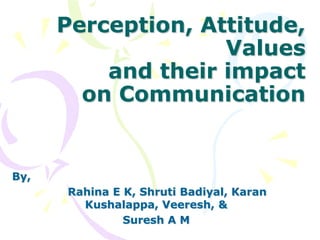Perception, attitude, beliefs & values
•Download as PPTX, PDF•
12 likes•32,706 views
Report
Share
Report
Share

Recommended
Big 5 model of personality & organizationally relevant personality traitsBig 5 model of personality & organizationally relevant personality traits

Big 5 model of personality & organizationally relevant personality traitsAl - Qurmoshi Institute of Business Management, Hyderabad
Recommended
Big 5 model of personality & organizationally relevant personality traitsBig 5 model of personality & organizationally relevant personality traits

Big 5 model of personality & organizationally relevant personality traitsAl - Qurmoshi Institute of Business Management, Hyderabad
More Related Content
What's hot
What's hot (20)
Notes on Perception in organisation Behavior (Notes for BBA/B.com Students)

Notes on Perception in organisation Behavior (Notes for BBA/B.com Students)
Notes on personality in organisation behavior (For BBA/B.com Students)

Notes on personality in organisation behavior (For BBA/B.com Students)
Interpersonal skills & entrepreneur by muhammad shahbaz atish

Interpersonal skills & entrepreneur by muhammad shahbaz atish
Group Behavior – Meaning, Types of Groups, Group Process, Group Dynamics – fa...

Group Behavior – Meaning, Types of Groups, Group Process, Group Dynamics – fa...
Organizational Behavior - Values, Attitude, Job Satisfaction

Organizational Behavior - Values, Attitude, Job Satisfaction
Similar to Perception, attitude, beliefs & values
Similar to Perception, attitude, beliefs & values (20)
Personality development study material by mr zeeshan nicks

Personality development study material by mr zeeshan nicks
Communication and Its effectiveness in work efficiency

Communication and Its effectiveness in work efficiency
Leadership Communication for effective organization .pptx

Leadership Communication for effective organization .pptx
Chapter 8 Introduction to Life Skills_270721091412.pptx

Chapter 8 Introduction to Life Skills_270721091412.pptx
Perception, attitude, beliefs & values
- 1. Perception, Attitude, Values and their impact on Communication By, Rahina E K, Shruti Badiyal, Karan Kushalappa, Veeresh, & Suresh A M
- 2. Perception: What you see is what you get Perception is the organization, identification and interpretation of sensory information in order to represent and understand the environment.
- 4. Four Steps of the Perception Process 1. Selection: What attracts your attention? 2. Organization: Along with selecting information, we must arrange it in some meaningful way 3. Interpretation: Classification 4. Negotiation: Sense-making occurs between people as they influence one another’s perception
- 6. The Role of Perception in Communication Sender Receiver What is sent What is received Motivation Perception Communication method/media Motivation Perception
- 7. Types of Perception in Communication Self-Perception Environmental Learned Physical Cultural
- 8. How might you increase your accuracy in perception? Perceive critically Recognize your role in perception, avoid early conclusions, and avoid mind reading. Check your perceptions; describe what you see or hear and ask for confirmation. Reduce uncertainty: For example, by lurking before actively participating in an Internet chat group, collecting information about the person or situation, interacting and observing the situation. Be culturally sensitive; recognize the differences between you and others and also the differences among people from another culture.
- 9. Attitude Attitudes are defined as a mental predisposition to act that is expressed by evaluating a particular entity with some degree of favour or disfavour. Individuals generally have attitudes that focus on objects, people or institutions.
- 10. Attitudes are of two types Positive attitude : More Participation in the Conversation. More Likely To Listen. Helps Maximize Strengths and Minimize Weaknesses. Increased Interaction Among Members.
- 11. Negative attitude; Inability to Accurately Judge. Incomplete Communication. Inability to See Problems. Conflict
- 12. Values Basic Conversations that a specific mode of conduct or end state of existence is personally or socially preferable to an opposite or converse mode of conduct or end state of existence.
- 13. Some common personal values are Success Accuracy Beauty Challenge Friendship Fun Reliability Respect for others Results-oriented Rule of Law Safety Satisfying others Security Self-reliance Cleanliness, orderliness Collaboration Commitment Communication
- 14. Few Examples of Values I. Leadership - The courage to lead from front and shape future. II. Balance- Maintaining Healthy life and work balance for workers. More on Work Life Balance III. Collaboration - Collaborating within and outside the company to give the best. IV. Passion - Putting the heart and mind in the work to get the best.. V. Community - A sense of responsibility and contribution to society that define our existence.
